What is Schema Markup and Schema.org
Schema markup is a structured metadata vocabulary that provides meaning and context about the content itself. It is like a blueprint for how to organize data.
To assure standards for Schema Markup across systems, the top search engines – including Google, Yahoo, Bing, and Yandex – first started collaborating to create
Schema.org back in 2011. For more information on Schema.org, read our article ‘
What is schema.org?’.
The Schema Markup standards defined by Schema.org help search engines better understand the content on your website and its context in order to serve rich results (aka rich snippets). This structured data allows search engines to see the meaning (semantics) and relationships between entities mentioned on your site and other websites.
For example, using recipe and video schema markup allow search engines to understand that your content is a cooking recipe, which recipe and that the format is a video, not text. And that based on those criteria, it will be displayed differently in search results as compared to the blue links.

Recipe Schema with Image

Recipe Schema with Video
Some additional Notes about Schema:
Schema.org does not define guidelines or limitations for the implementation of Schema Markup. Those are defined by whoever controls the implementation in a system. For example Google defines the rules for Schema Markup implementation in Google, and Bing for Bing and so on.
This means that Google can define within its systems how many characters a Description attribute can have or the dimensions of images. Bing can define different rules for Schema properties and attributes within its system.
Schema.org is not the only open standard for data, but it is the standard most commonly used by search engines. Some other schemas of structured data include
Open Graph and
Dublin Core.
What is the purpose of Schema Markup

The whole point of structuring your data in the form of Schema Markup is to communicate better with systems like search engines.
Schema Markup is a form of standardized metadata. It provides meaning or context about content to search engines like Google. This has important implications for Search Engine Optimization (SEO).
In the age of Artificial Intelligence (Examples Hummingbird and RankBrain) Schema markup influences how a search engine interprets the content of your website, the context of a query and the quality of search results.
For this reason, schema markup and structured data have become a hot topic of SEO.
Schema markup brings us also closer to the realization of the
Semantic Web, aka Web 3.0. One of the goals of the Semantic Web is to facilitate the communication between humans and machines, applying standards such as Schema.org, RDF, SPARQL and OWL.
SEO Benefits of Schema Markup

The ultimate goal for Google is to provide the best user experience possible. Providing the best user experience translates into elevated market position and increased advertising revenue.
So what does Schema
Markup have to do with user experience? (Answer: very much!)
First of all, nobody likes to perform a search and get results that are not relevant. Google has become rather good at understanding our search intent, but sometimes misses the mark, to our frustration. The difficulty for Google’s algorithm is in semantics - the meaning of our search, the meaning of the content on a webpage.
Schema helps search engines decipher meaning and this provides better results and thus better user experience.
But Schema goes beyond the mere adding of context. Schema is also used to display search results in rich snippets, innovative ways to show results and query related information in multiple forms.
Let’s analyze the results of the ‘How to install a water pump?’ query.
Google doesn’t show any commercial offering but only ‘How to’ content:
The very first result is a
‘featured snippet’ of a video with a title that matches my search exactly; it is fairly recent and has a lot of views. It is featured because “We [Google] display featured snippets when our systems determine this format will help people more easily discover what they’re seeking, both from the description about the page and when they click on the link to read the page itself.”
 ‘People also ask’
‘People also ask’ section
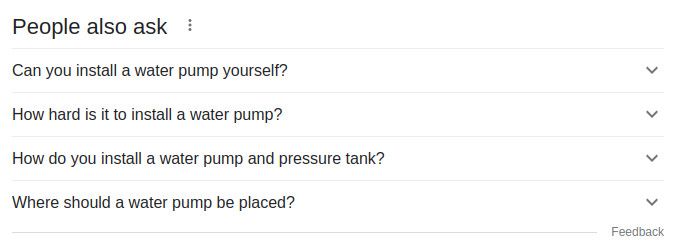 Breadcrumbs & step-by-step schema
Breadcrumbs & step-by-step schema

We then changed our search to ‘Buy a water pump’ and found some rich results with
thumbnail schema:
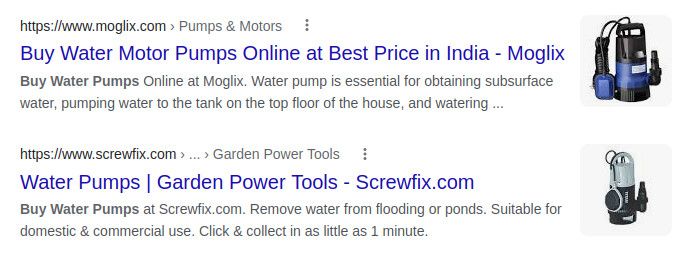
Providing rich search results in a variety of formats has greatly improved the user experience over the years.
Let’s review what benefits the implementation of Schema Markup can have with regards to Search Engine Optimization (SEO).
Click-Through-rate (CTR)
Probably the most important and immediate SEO benefit of implementing Schema markup is that it allows search results to be displayed in several richer formats that increase visibility and usefulness as seen above. This catches attention and increases organic traffic.
By providing better, more focused content that meets the search intent of the user, that traffic can also translate into higher conversion rates on your website, and most importantly an increase in revenue.
According to
Search Engine Land, by implementing schema, you could get a 30% increase in click-through rate.
Search Ranking
Let’s make this clear from the start - there is no statement or evidence that implementing Schema
Markup by itself directly improves your position in search engine results pages (SERP). Don’t we all wish!
However, the CTR is one of the factors that influences your ranking, and if implementing Schema
Markup improves your CTR, it may indirectly improve your ranking, which may further improve CTR … You have struck SEO Gold!
But don’t forget, SEO is about humans and humans are looking for the most relevant content. Good SEO practices with well-structured data (Schema Markup) on your pages helps search engines read that content. This improves CTR on your snippets, but you also have more people seeing those snippets. In other words, a well-structured page ranks higher. Here’s what affects those high rankings:
- Relevance — search engines have a better chance to find out how relevant your content is.
- Domain/page authority — schema markup is one of the factors that affect domain and page authority rates.
- CTRs — high CTRs indicate that the page’s content is appealing to users, so it’s more relevant and should rank high.
In conclusion, the only way that schema can hurt you is if your competitor is using it and you are not. Err on the side of excess - it’s better to apply one schema type too many than none at all.
Types of Schema Markup for SEO
There are hundreds of schema markup types defined by Schema.org. We refer to their website to view the entire list. Below you will find an overview of the most important and commonly used types of Schema Markup for SEO.
Navigation Schema Markup
Schema.org Reference:
https://schema.org/SiteNavigationElement
Purpose: With up to six pages listed below your site’s title tag and meta description, you can use the site navigation schema markup to point users directly to your site’s subpages. Each site link can have unique title tags and meta descriptions for your site’s subpages.
These site links are a great way to draw traffic directly to specific pages on your site and you can even add a ‘Contact Us’ site link using the site navigation schema markup.
Rich Search Results Example:
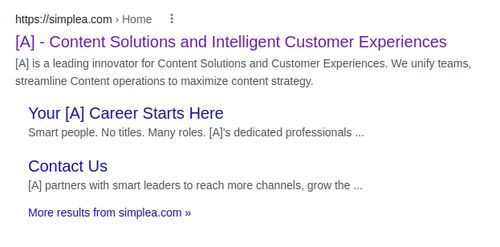
Webpage Schema Markup
Schema.org Reference:
https://schema.org/WebPage
Purpose: The WebPage type allows you to declare a number of useful properties about each web page of your site. These include the main subject, main image, about, description, and many others that provide general context about the content of a specific page.
Rich Search Results Example:
A Webpage schema example in its simplest form:
Breadcrumbs Schema Markup
Schema.org Reference:
https://schema.org/BreadcrumbList
Purpose: The breadcrumbs schema type is specifically used to display the web page in the web architecture hierarchy as breadcrumbs in search results. It is structured as an ordered list and can contain as many list items as the hierarchy of your website requires.
Rich Search Results Example:

Organization Schema Markup
Schema.org Reference:
https://schema.org/Organization
Purpose: The Organization schema shows users a short description of the organization, the company logo, location, and contact information. It is one of the most important schema types as it not only displays very prominently but is also used in the Google Knowledge Graph to identify your organization as an entity and its relationships with other entities.
For businesses that are active on social media platforms, the organization schema is also a great way to link relevant company profiles.
Rich Search Results Example:
Person Schema Markup
Schema.org Reference: https://schema.org/Person
Purpose: The Person markup communicates basic information about an individual mentioned on the page to search engines.
The Person markup helps Google identify an individual as an entity. By adding more schemas, like Organization, for example, you’re helping Google establish relations between different entities.
The tangible benefit of applying the Person Schema may be a comprehensive Knowledge Graph with all the details about a certain person.
Rich Search Results Example:
Local Business Schema Markup
Schema.org Reference: https://schema.org/LocalBusiness
Purpose: Applying the LocalBusiness schema is important for any business with a physical store. When people search for products or services, Google will use the users’ location to offer results within the users’ location. Google offers the most relevant stores as well as their location in Google Maps.
Rich Search Results Example:
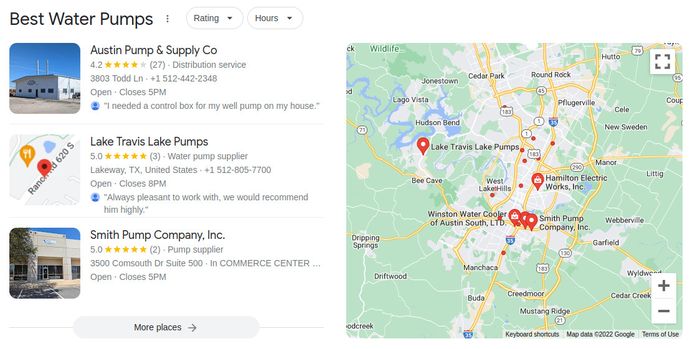
Product & Offer Schema Markup
Schema.org Reference:
https://schema.org/Product
https://schema.org/Offer
Purpose: The Product Schema type can be used for any individual product or service being offered on a website. If a webpage displays more than one product, it is appropriate to add schema markup for each product on that page.
The Offer schema markup concept might be a bit confusing and needs a bit of explaining. It does NOT refer to any type of discount, promotional price, also considered an ‘offer’. The offer scheme refers in a much broader sense to the offering of a service or product for a price. As such ‘offer’ should be regarded as a transfer or trade. The properties often used in conjunction with the offer type are Availability (In stock, Out of stock, Pre-order, etc.), price, pricecurrency, serial number. It is often used in combination with other types such as rating, review or product.
Rich Search Results Example:


Rating/Review Schema Markup
Schema.org Reference:
https://schema.org/Rating
https://schema.org/Review
Purpose: The review schema type is used to list one or more reviews - opinions about your product or service.
The rating schema type can be used to show the overall rating (average) or the rating given by each user, as well as a best and worst rating.
The complexity of this schema is that you will likely need a developer to automate a process to feed the values of the reviews and ratings you receive into schema markup.
Rich Search Results Example:

Event Schema Markup
Schema.org Reference: https://schema.org/Event
Purpose: The event type can be used for a wide array of events from a concert, a Lady’s night at a bar or an online webinar. Event Schema can be used for many event types, both with physical location or online. Events are displayed in search results based on geolocation or Organization, Person etc. As such, a person looking for an organization or person sees the events organized by it, or a person searching for events in a location will see all the events in that location from any organizer.
Rich Search Results Example:

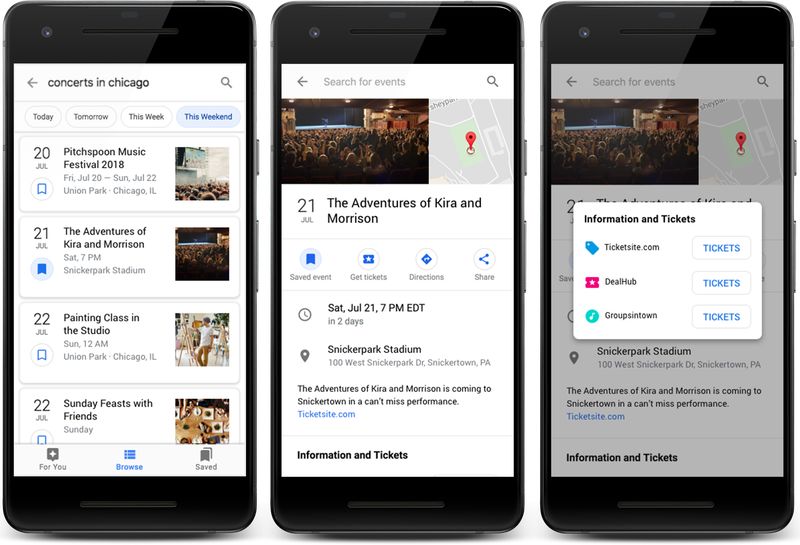
Article (and related) Schema Markup
Schema.org Reference:
https://schema.org/Article
https://schema.org/BlogPosting
Purpose: Adding Article structured data to your news, blog, and sports article page can enhance your appearance in Google Search results.
Rich Search Results Example:

VideoObject Schema Markup
Schema.org Reference: https://schema.org/VideoObject
Purpose: While Google tries to automatically understand details about your video, you can explicitly provide information, such as the description, thumbnail URL, upload date, and duration, by marking up your video with VideoObject Schema. Videos can appear in Google Search results, video search results, Google Images, and Google Discover.
Rich Search Results Example:
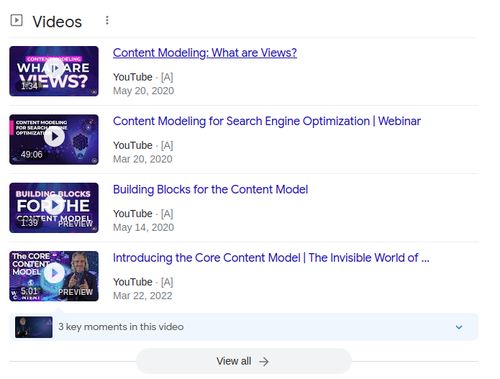
Job posting
Schema.org Reference: https://schema.org/JobPosting
Purpose: You can improve a job seeking experience by adding JobPosting structured data to your job posting web pages. The JobPosting schema will help ensure that your posting will be included in Google job postings.
Rich Search Results Example:
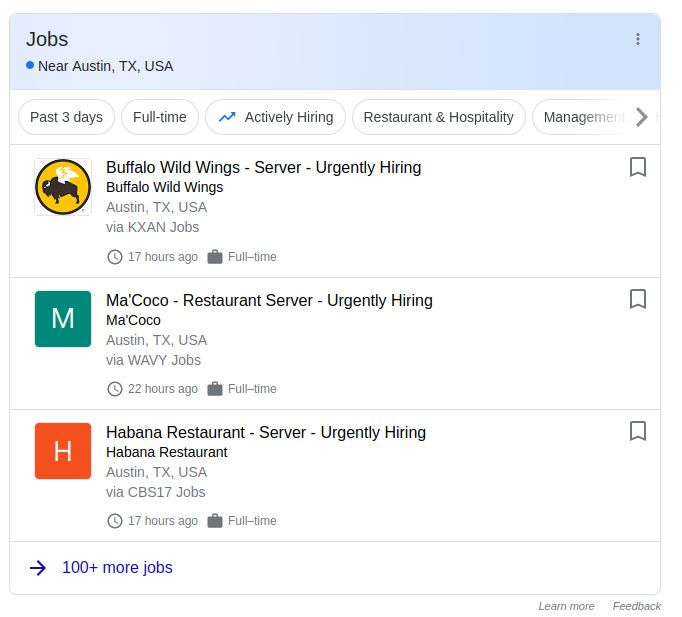
Course
Schema.org Reference: https://schema.org/Course
Purpose: Mark up your course lists with structured data so prospective students find your most popular courses directly through Google Search.
Rich Search Results Example:

Implementing Schema Markup
Once you are familiar with Schema Markup types, the next step is to implement Schema Markup on your website.
Depending on the complexity of your website and content as well as the financial and human resources available, this could be an easy or a daunting task. Although Schema Markup itself is not very complex, there is more to implementing it correctly and effectively than meets the eye.
Besides taking a moment to decide which Schema types to implement on which pages, schema markup implementation requires a strategy, mapping out the ‘content’ or values for all the properties, automating the ‘data-entry’ for some of the properties, as well as figuring out which tools are available to you or which to use. Bridging the content supply chain with technology and automating this process is part of what we consider to be Content Engineering.
To learn more about how to implement schema markup for your website, read our article ‘How to implement schema markup on your website?’.
Helpful Resources
Figma SchemaFlow Widget
Simple [A] has developed a very useful and
Free Schema mapping widget for Figma called SchemaFlow. It allows you to visualize all the schema types to implement and on which pages, and to list all the attributes you wish to use.
What makes this tool unique and extremely useful, is that you do not need to research all the properties, the tool provides all the options in the form of dropdowns and you can just select the properties. You can create hierarchies (nested types) and the tool will show the hierarchies.
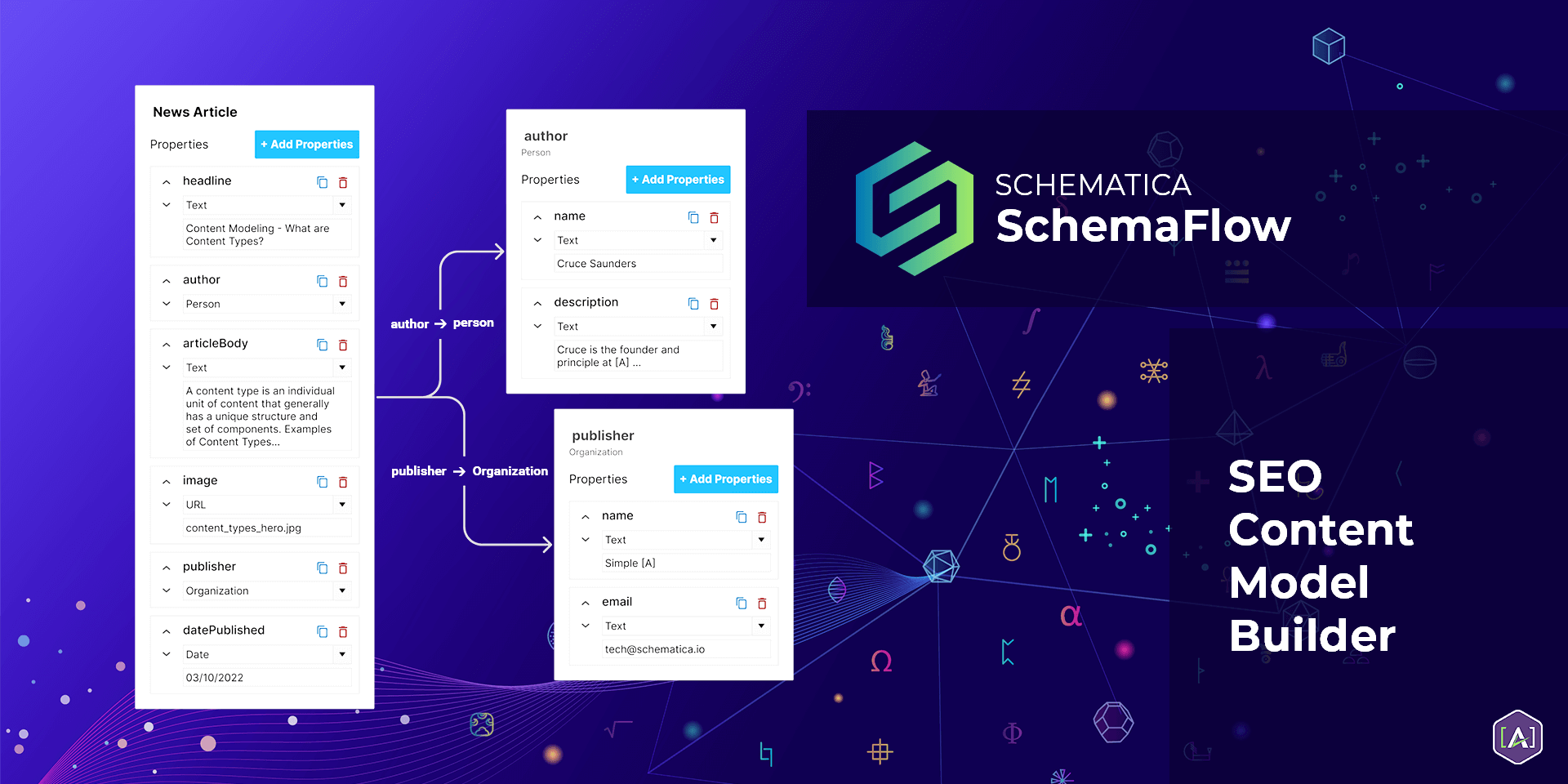
To jumpstart your schema model, get
SchemaFlow!
Free Schema Markup & Structured Data for SEO Implementation Guide
This Guide dives deeper in the use of Schema Markup and the implementation, specifically for large content-rich organizations that use headless CMS.
The guide explores the steps in defining a Schema Markup implementation strategy, how to integrate Schema within their CMS, as well as how to use Content Modeling and Content Engineering practices to automate content authoring and publishing processes for personalized omnichannel content delivery and user experiences.
Get help from [A]’s Content Engineering Experts
Simple [A]’s Content Engineers are experts with years of experience in implementing Content Management Systems in large organizations. [A]’s expertise lies mainly but not exclusively in implementing headless component content management systems and Jamstack architectures.
Simple [A] distinguishes itself by its holistic approach to Headless CMS solutions, applying our content modeling and Content Engineering expertise, to assure companies have highly streamlined, efficient content supply chains from authoring to multi-channel publishing, while at the same time fostering personalized, next-level Customer Experiences using a Content-as-a-Service (CaaS) model.
Simple [A] is a Kentico, Sitecore and Contentful partner, but we can assist with the implementation of any headless CMS on the market or even assist in developing a custom CMS.
Simple [A] assists organizations along this entire process ensuring the journey is frustration-free and frictionless, and has a successful outcome for your organization.
[A] assists Organizations adopting Content Engineering practices through a number of services:
- Audits of your current organizational structure, available human resources and technology
- Consulting on Content Engineering implementation
- Workshops on Content Engineering
- Guiding your organizations’ Digital Transformations to adopt Content Engineering
- Manage Content Engineering practices for organizations
- Develop and implement Content Models, including Schema.org, DITA and other Markup
Contact Us for a Free Consultation.